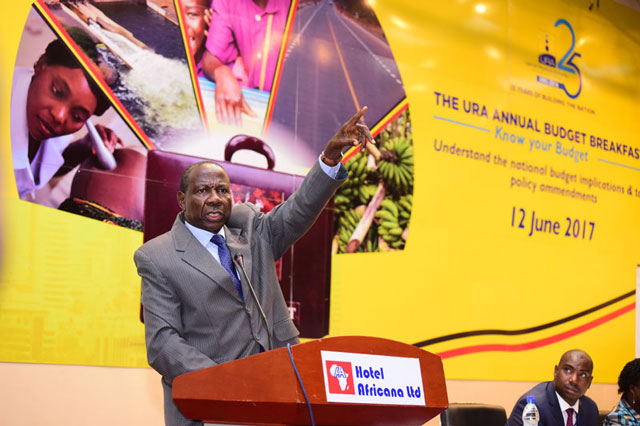
`We can’t build a mixed economy when the private sector side is parasitic on the public sector’
NRM programme point No. 10. Following an economic strategy of mixed economy
When the NRM government took power in 1986, it introduced a 10-point programme. Point No.10 on the programme was to pursue a mixed economy strategy. The Independent’s Isaac Khisa spoke to leading economist, Dr. Fred Muhumuza, from the College of Business and Management Science, Makerere University, about NRM’s record on that goal after 33 years of NRM in power.
The NRM government undertook a mixed economy once it took power in 1986. What is your assessment of NRM’s performance on this type of economy over the past three decades?
It was a proper aspiration at the time because most countries have reverted to the mixed economy, finding a location between extreme capitalism and extreme socialism. But it has yielded mixed results for Uganda. After 30 years, the private sector remains immature. Where the private sector is supposed to complement government, the expectations to grow the economy remain hinged on government projects. Mixed economy should have been riding on market opportunities triggered by government investments and policies such as conducive environment, low interest rates, moderate exchange rates and low inflation. Initiatives like Operation Wealth Creation and NAADs should have been private led. Given that framers of the mixed economy were still in the bush, nobody had planned how the mixed economy will materialise. It was a coincidence that it happened when the World Bank and the International Monetary Fund were telling them to liberalise and privatise; scale back government involvement. The few private sector investments seen today, one can argue, are by people stealing public funds and investing in private initiatives.
What is your view on the government’s role in regulating export-import, MPC, inflation, and exchange rate as was envisaged in the mixed economy?
These are largely in the domain of the public sector. However, it is difficult to judge their performance based on what they anticipated. They didn’t expect the public sector to take over exchange rates – that is determined by imports and exports which is largely driven by the private sector. The public sector should only do infrastructure investments, policy and regulations, and encourage the private sector to thrive. Monetary policy is supposed to merely intervene and stabilise the shilling. But given the shilling has not been stable, I don’t think performance has been adequate.
So where did the government go wrong?
I think the NRM government did not have time, effort and possibly interest to see how to actualise the mixed economy. They found the economy in a bad shape and urgently needed foreign exchange. It made them to think long term strategies. Some decisions were right; like the liberalisation of exchange rates but they needed to think through the short term, medium term, and long term. This, unfortunately, has come to haunt the economy as most of the assumptions about the mixed economy have not been realised. For instance, there was an assumption that liberalising the economy will attract both local and foreign investments, and that privatised former non-performing government entities will perform better. Some successes happened in the telecoms and beverages, but not in agriculture.
How can this situation be reversed?
We need to get back to the same argument of the mixed economy but this time be deliberate and logical. Not this business of Operation Wealth Creation providing farmers with inputs. Inputs needs to be provided by private entity engaged at a higher level of processing in the value chain not the government operating on the mode of civil service. We have seen factories come up but not have enough inputs; an abattoir on Bombo Road lacks cattle to slaughter, the steel industry is dependent on imported iron raw materials. Dealing with corruption will ensure that a right private sector emerges. We can’t build a mixed economy when the private sector side is parasitic on the public sector.
Where do you see the country in a few years to come if nothing changes as you suggest?
The trend has been downwards. The economy used to grow at 8-9% and then it came down below 3%. Now you cannot be happy when it grows by 5% yet the target was 7%. The signals are not the right. Interest rates are high, partly driven by the public sectors need to borrow. These are affecting the fundamentals of the economy.
But there’s an argument that the government investment in infrastructure will drive growth of the economy?
We have had that discussion for the last 10 years. Government projects were expected to drive the economy. Regrettably, those investments give you growth at the time of happening but what you need is sustainable growth. The completion of Bujagali Hydropower dam contributed to the growth that year but Bujagali hasn’t continued spurring private sector growth because all the energy investments have not reduced the tariff. Electricity and water bills are going up. Inflation, though stable at a rate of 4-5% over 10 years, means those prices are always going up. The cost of living is also going up. Therefore one cannot claim that the investments will in future favour the government.
Looking at the trend of the value of the shilling against other international currencies, where are we?
Definitely in 1986, there was hardly any dollar. It was a completely a black market. But we don’t want to compare with that extreme case. Sufficient investment should have turned that around. The gradual decline in the value of the shilling tends to discourage local and foreign investors who need dollars.
 The Independent Uganda: You get the Truth we Pay the Price
The Independent Uganda: You get the Truth we Pay the Price



